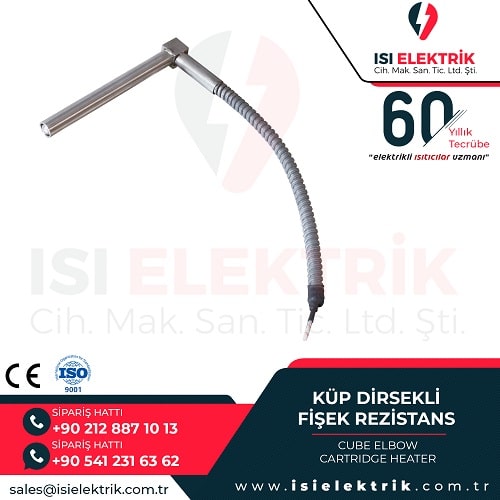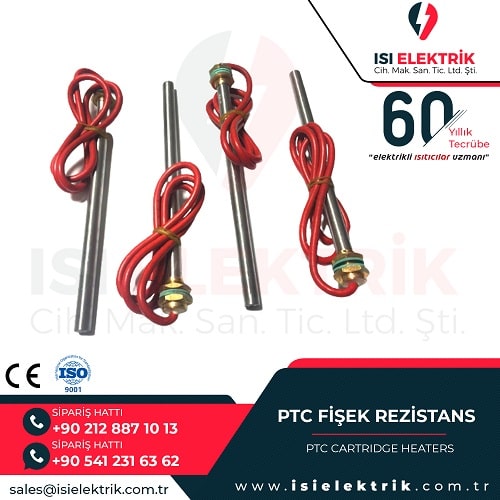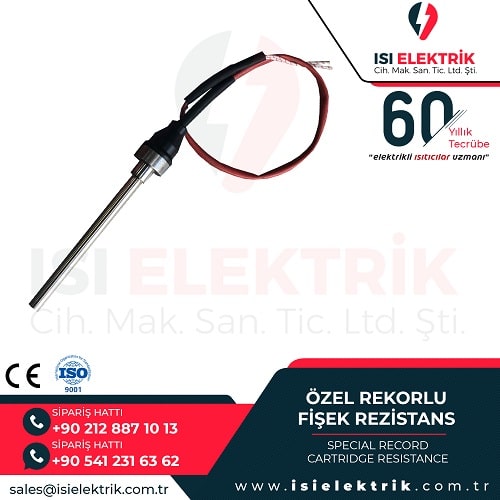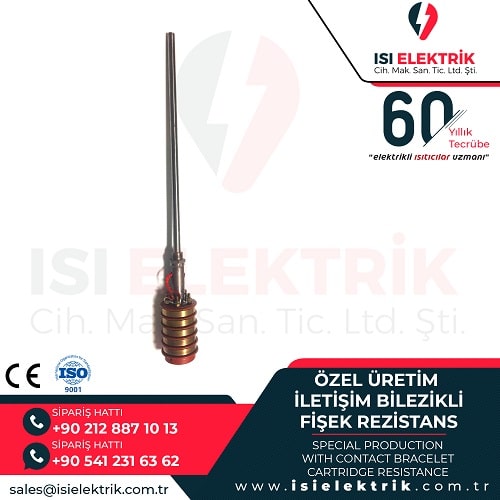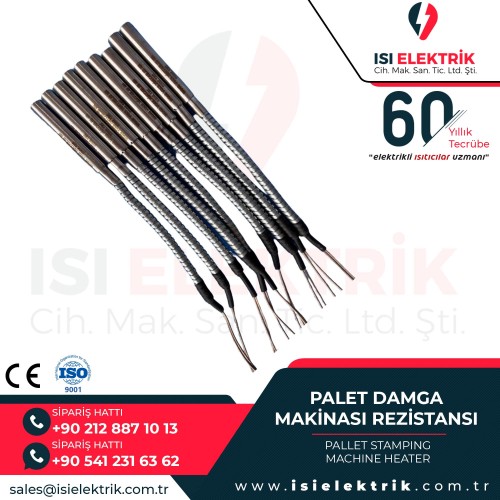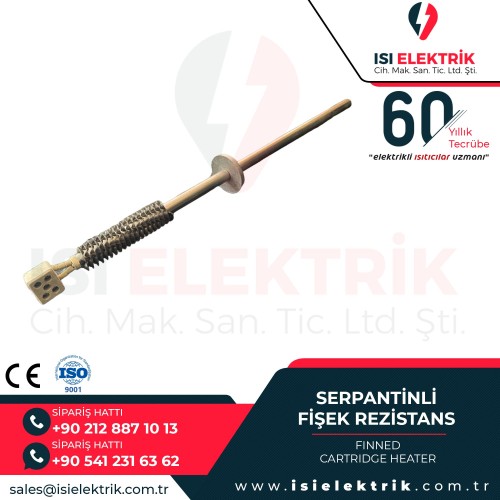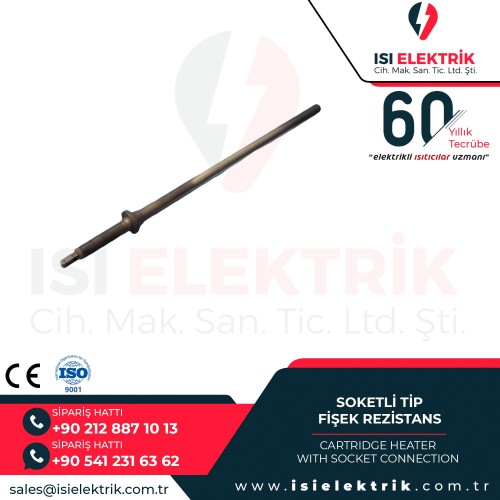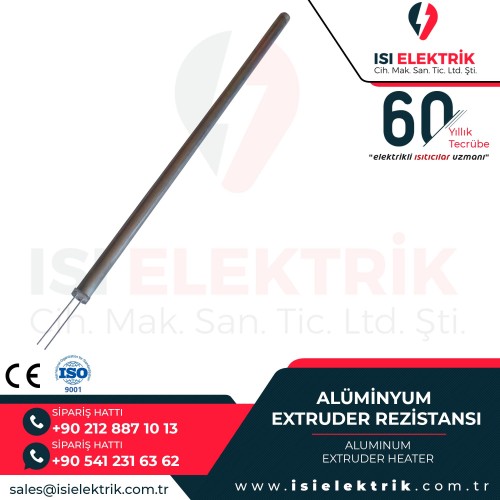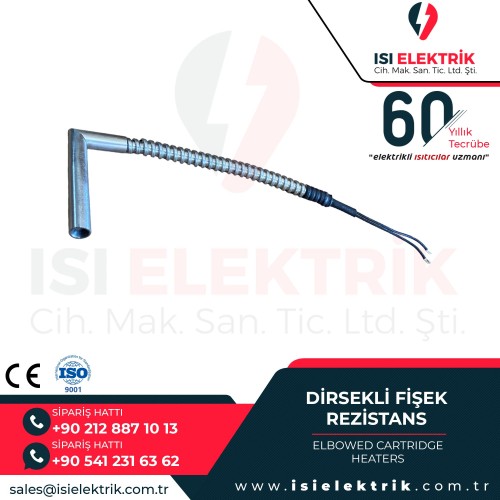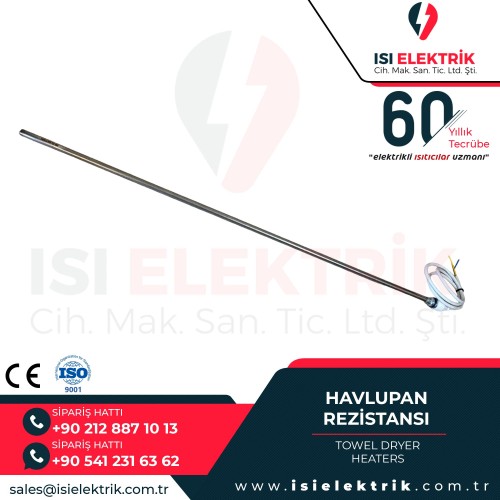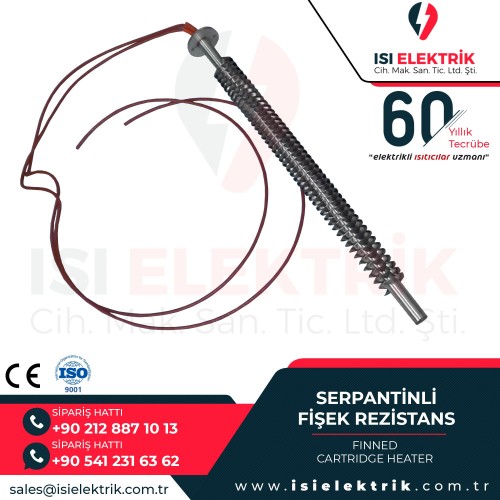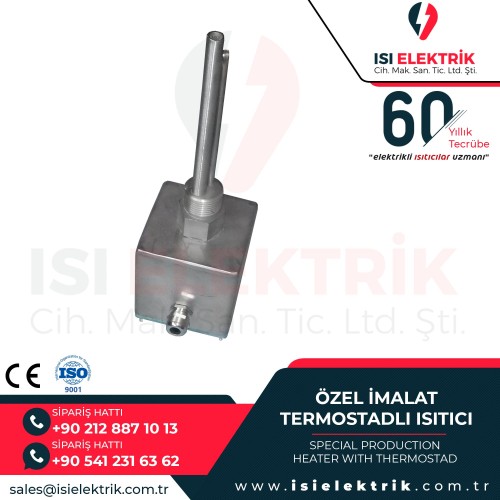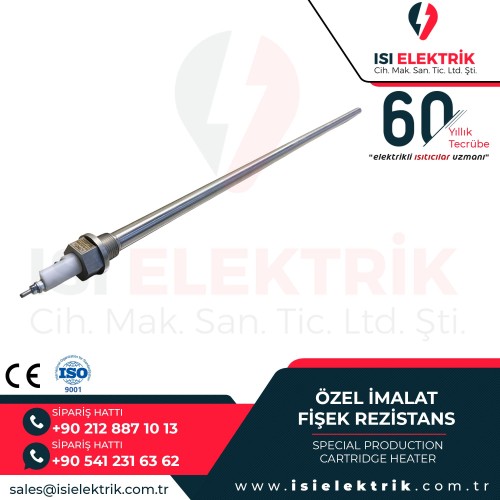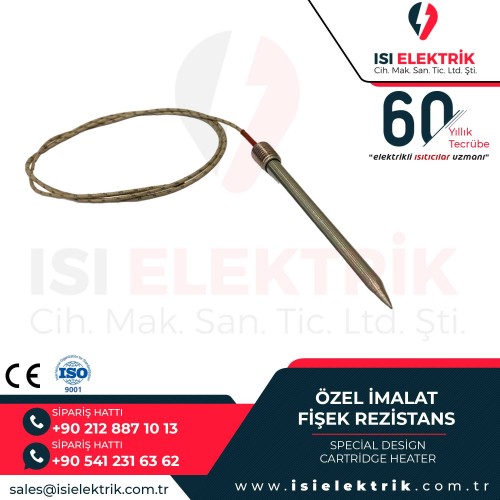Cartridge Heaters
Cartridge heater is a type of resistance which is used for heating molds and presses. The production of those tubes is fulfilled by calibration after the insulation process on the outer tube sheath with magnesium oxide powder due to the wrapping of the equal rolled gaps around the ceramic stone.
The jaws of packaging machines are heated in these heaters. They are new generation resistance types that can also be used for heating water, oil, and corrosive liquids. In these products, mgo powder between the resistance wire and the tube sheath is thin. Thus, a fast and efficient heat can be obtained. Very little energy is spent for the heat obtained in such a short time thanks to Mgo powder.
Cartridge type heater items with high Watt power provide a very strong
heating performance in any environment and mold which has electrical heating. Therefore, cartridge heaters offer effective solutions in gaining the
most effective heat under heavy working conditions.
In Which Areas Are Cartridge Heaters Used?
Cartridge heater types are used in many fields such as plastic and rubber processing, wood, food, and chemistry. They are produced in industrial areas to have different wattage. Thanks to their ergonomic design and high quality these products can easily adapt to any system and can satisfy all demands.
Cartridge type heaters can be used in all industries where molds and presses are heated. They are also preferred heater types in packaging machines. According to your needs, these heaters can be produced in different shapes, materials, and strengths according to your needs.
Cartridge Heaters Technical Specifications
• Cartridge heaters can be produced with various tube
diameters between 4 mm and 31.5 mm.
• The length of the products starts from 30 mm. At the
same time, there can be different lengths up to 5000 mm.
• We also produce 90 degree bent models. It is produced in
different types such as L type, cube elbow, elbow, steel braided armored,
spiral armor protected, flanged, bushed, and sleeved.
• In the production of cartridge heaters, stainless steel materials are
used such as 304 – 316 – 321 – 310S. Special alloyed stainless steels such as
Alloy800 – Alloy825 and Alloy600 can also be used.
• Flat tube cartridge heaters are also produced with new
generation technologies. Liquid, horizontal plates and
prese’s heating process can be done in these products.
• Cartridge heaters work at 600 degrees. Besides the
working temperature can reach up to 800 degrees.
• We also produce models with cable outlet, steel and spiral braided, ceramic insulated, silicone cable, union and flange connection outputs or stud connection outputs.
How To Select a Cartridge Heater?
Cartridge heater products are used in many industrial areas. Before ordering these products, you should first pay attention to the quality of the material. By using quality materials, cartridge type heaters can be used for many years. Our company uses the best quality items in all heater production.
In the same time, you should consider your needs when making a choice. You can also contact our customer service for the selection of the heater that will satisfy your needs. Our team will always help you with the choosing. Also, we give consultation to you in the choosing in terms of price/performance ratio.
Cartridge Heaters Prices
Contact us now if you want to get information about cartridge heaters prices.
We instantly inform you about the standard production heaters. We also produce
cartridge heater which is special production. You can get a price offer for
orders in special sizes and models immediately.
Cartridge Heater
A cartridge heater is a type of heating element that converts electrical energy into thermal energy. It is typically created by bending and winding metal wires in a specific pattern. These wires are usually made of high-resistance materials such as nickel-chromium alloys. When an electric current passes through the cartridge heater, the wires heat up due to their resistance and begin to emit heat to their surroundings. Cartridge heaters are commonly used in industrial and residential heating systems. They are particularly found in applications such as ovens, stoves, water heaters, refrigerators, dryers, and other heating appliances. Characteristics such as resistance, size, and shape can vary depending on the intended use and application requirements. Cartridge heaters are preferred for their ability to withstand high temperatures and their long lifespan.Applications of Cartridge Heaters
- Medical Devices: Cartridge heaters play an important role in medical devices, especially in laboratory equipment and sterilization systems. These heaters are used to maintain specific temperatures and provide consistent heat in various devices. In laboratories, cartridge heaters are preferred for devices that require precise temperature control, such as incubators, heat exchangers, and sterilizers, ensuring efficient operation of medical instruments and biological samples.
- Agriculture and Horticulture: In the agriculture sector, particularly in greenhouse operations, controlling temperature is crucial for plant growth. Cartridge heaters are commonly used in heating systems within greenhouses. These heaters help regulate the environment temperature, ensuring optimal conditions for plants to thrive. Additionally, they are used in agricultural machinery for heating and in equipment that operates in cold conditions, ensuring efficient performance in agricultural operations.
- Packaging Industry: In the packaging industry, cartridge heaters are used in temperature-controlled packaging machines and shrink-wrap machines. These heaters ensure that packaging materials are uniformly heated for proper sealing and packaging. The quick heating properties of cartridge heaters enhance productivity and minimize energy loss in packaging processes such as thermal labeling, packaging, and product wrapping.
- Electronics Industry: In the electronics industry, cartridge heaters are commonly used for soldering processes. During soldering, circuit boards need to be heated to high temperatures, and cartridge heaters are an ideal solution for providing the necessary heat. These heaters are also used in circuit board production, electronic device assembly, and testing, meeting the precise heating requirements of electronic applications.
- Maritime and Aerospace Industries: In the maritime and aerospace industries, cartridge heaters are used in climate control systems of marine vessels and aircraft. These heaters play a key role in maintaining temperature control within aircraft for passenger comfort and equipment functionality. Similarly, in marine vessels, cartridge heaters are used in engine heating systems and in preventing freezing in harsh weather conditions.
- Energy Sector: In energy production and distribution, cartridge heaters are used to heat infrastructure such as pipelines and tanks. These heaters are essential for maintaining temperature control and preventing freezing in energy systems, especially in cold environments. Additionally, cartridge heaters are used in energy storage systems, battery heating, and cooling processes to ensure efficient operation in energy-related applications.
Technical Specifications of Cartridge Heaters
- Electrical Power (Watt): Can range from 50W to 10kW.
- Voltage (Volt): Typically available in standard voltages such as 12V, 24V, 110V, 220V, 380V.
- Nominal Resistance (Ohm): Can vary between 1 Ohm and 1000 Ohm.
- Length and Diameter: Length can range from 50 mm to 2000 mm, and diameter can range from 3 mm to 20 mm.
- Material: Typically made of nickel-chromium alloy.
- Maximum Operating Temperature: Can vary between 100°C and 1200°C.
- Heat Distribution: Varies between 10 W/cm² and 50 W/cm².
- Protection Systems: Protection systems such as overheat protection, overcurrent protection may be available.
Advantages of Cartridge Heaters
- Low Maintenance Requirement: Cartridge heaters generally require low maintenance. They can be easily cleaned and offer long-lasting performance with regular maintenance.
- Flexibility: Cartridge heaters can operate over a wide temperature range, making them versatile for various industrial applications and environmental conditions.
- Safety: Being powered by electricity, cartridge heaters are generally a safer heating solution. They are safer in areas where flammable gases or liquids are present.
- Accurate and Homogeneous Heating: Cartridge heaters provide homogeneous heating across the material. This enhances product quality and process efficiency.
- Environmentally Friendly: Cartridge heaters are a heating solution that produces less waste and fewer pollutants. They have a lower environmental impact since they do not use fuel.
- Compact Design: Cartridge heaters typically have a compact design, which saves space and increases installation flexibility.
Technical Considerations for Selection of Cartridge Heaters
- Power (Wattage): It is important for the heater's power to match the application requirements. Adequate power ensures reaching the desired temperature levels.
- Voltage: The heater should be compatible with the voltage of the electrical system it will be used with. Incorrect voltage levels can affect the heater's performance.
- Material: The choice of heater material should be based on the intended use and operating conditions. Nickel-chromium alloy is commonly preferred.
- Operating Temperature: The maximum operating temperature of the heater should be suitable for the application requirements. A heater capable of meeting the desired temperature range should be selected.
- Dimensions: The length, diameter, and shape of the heater should be suitable for the installation area and application requirements. Dimensions should be appropriate for the available space.
- Heat Distribution: It is important for the heater to distribute heat evenly. Good heat distribution helps achieve the desired temperature profiles.
- Protection Systems: Some heater models come with protection systems for situations such as overheating or overcurrent. Such features are important for safety and longevity.
- Application Area: The environmental characteristics where the heater will be used should be considered during the selection process. For example, industrial environments may require more durable and high-performance heaters.
- Lifespan and Maintenance Ease: A long lifespan and ease of maintenance are preferred for heaters. Heaters with a long lifespan and low maintenance requirements can reduce operating costs.
Achieving Energy Savings with Cartridge Heaters
Cartridge heaters are heating elements that play a crucial role in increasing energy efficiency and providing energy savings in both industrial and commercial applications. These heaters convert electrical energy directly into heat, minimizing energy losses and ensuring more efficient use of heat. Features such as high temperature resistance, rapid heating capabilities, and uniform heat distribution make cartridge heaters highly effective in energy savings.
Energy Savings through High Efficiency
- Cartridge heaters are designed to provide energy efficiency. These heating elements produce more heat with lower energy losses. The process of converting electrical energy into heat is highly efficient, reducing the amount of energy used to a minimum. The high temperature resistance of cartridge heaters allows for quick heat production and rapid achievement of required temperature levels. This enables heating systems to achieve more efficiency in a shorter amount of time. As a result, using cartridge heaters optimizes energy consumption and reduces energy costs for businesses.
Reduced Energy Loss
- Another advantage of cartridge heaters is the reduction in energy loss. During the conversion of electrical energy into heat, minimal loss occurs. This allows the heating system to generate more heat with less energy consumption. Energy loss usually occurs when heating systems operate inefficiently. However, cartridge heaters minimize these losses, optimizing energy use. As a result, businesses pay lower energy bills, and the environmental impact is significantly reduced.
Rapid Heating and Even Heat Distribution
- One of the key features of cartridge heaters is their ability to provide rapid heating and even heat distribution. The heating elements reach the desired temperature quickly, allowing the system to operate efficiently in a shorter time. Additionally, they distribute heat evenly across the entire surface, preventing heat loss and providing more efficient heating. This even heat distribution not only promotes energy savings but also contributes to the long lifespan of the equipment being used.
Long-Term Efficient Use
- Cartridge heaters are made from high-quality materials, offering long-term, reliable performance. Resistant to corrosion and wear, these heaters provide high efficiency in industrial processes. The use of these heating elements, which are designed to provide energy savings, is particularly preferred in industries with continuous heating requirements. Their durability reduces maintenance and replacement costs over time, making the process of achieving energy efficiency more cost-effective.
Cartridge Heater Features Providing High Heat Efficiency
Cartridge heaters are crucial components in industrial heating applications due to their ability to provide high heat efficiency. These heaters convert electrical energy into heat with high efficiency, producing more heat with less energy. Heat efficiency not only helps save energy but also supports the longer lifespan of devices. The features of cartridge heaters that contribute to their high heat efficiency are as follows:
- High Electrical Resistance: Cartridge heaters generate more heat due to their high electrical resistance. This high resistance allows the heating elements to produce maximum heat with minimal energy consumption.
- Rapid Heating: Cartridge heaters can reach high temperatures in a very short time. This fast heating process ensures that energy is used more efficiently.
- High Temperature Resistance: Cartridge heaters are made from materials that can withstand high temperatures. This ensures long-lasting efficient performance at high temperatures and minimizes energy losses.
- Even Heat Distribution: Cartridge heaters ensure that heat is distributed evenly across the entire surface. This feature reduces energy losses and enables more efficient heating.
- High Thermal Conductivity: Cartridge heaters have the ability to transfer heat quickly and effectively. This allows for more efficient heat transfer, contributing to energy savings.
The high heat efficiency features of cartridge heaters help businesses reduce energy costs while promoting a more environmentally friendly approach. Additionally, their long lifespan and lower maintenance requirements result in significant cost savings over time.
Fişek Rezistans Teknik Detayları
Fişek rezistanslar, elektrik enerjisini ısıya dönüştüren yüksek verimli ısıtma elemanlarıdır. Endüstriyel ısıtma sistemlerinde yaygın olarak kullanılan bu cihazlar, özellikle yoğun ısı üretimi gerektiren uygulamalarda tercih edilmektedir. Fişek rezistanslarının teknik özellikleri, performanslarını ve verimliliklerini doğrudan etkileyen önemli faktörlerdir. Bu rezistansların tasarımında kullanılan malzeme türleri, elektriksel direnç değerleri, çalışma sıcaklıkları gibi özellikler, her türlü endüstriyel uygulama için kritik öneme sahiptir.
- Kullanılan Malzemeler: Fişek rezistansları genellikle nikel-krom (NiCr) ve demir-krom-alüminyum (FeCrAl) alaşımlarından üretilir. Nikel-krom alaşımları, yüksek elektriksel direnç ve esneklik sunarken, FeCrAl alaşımları ise yüksek sıcaklık dayanımına sahip olup uzun ömürlü kullanım sağlar. Bu malzemeler, rezistansın dayanıklılığını ve verimliliğini artırırken, aynı zamanda oksidasyon ve korozyona karşı direnç gösterir.
- Elektriksel Direnç: Fişek rezistanslarının elektriksel direnci, kullanılan malzemeye, telin uzunluğuna ve çapına bağlı olarak değişir. Yüksek direnç, daha fazla ısı üretimi sağlar. Ancak, direnç arttıkça enerji tüketimi de artabilir, bu nedenle uygulamaya uygun doğru direnç seçimi önemlidir. İyi bir direnç değeri seçimi, hem enerji verimliliğini hem de ısıtma süresini optimize eder.
- Çalışma Sıcaklık Aralığı: Fişek rezistansları, genellikle 100°C ile 1200°C arasındaki sıcaklıklarda çalışabilir. Yüksek sıcaklıklarda uzun süreli ve verimli çalışma sağlayan fişek rezistansları, çeşitli endüstriyel uygulamalar için uygundur. Bu rezistanslar, yüksek sıcaklık uygulamalarında oksidasyona karşı koruyucu bir oksit tabakası oluştururlar ve böylece daha uzun süre dayanıklılık gösterirler.
- Korozyon Direnci: Fişek rezistansları, genellikle asidik veya nemli ortamlarda kullanılmak üzere tasarlanmış malzemelerden üretilir. Bu nedenle, korozyona karşı yüksek direnç göstermeleri çok önemlidir. Özellikle deniz suyu veya kimyasal ortamlarda çalışan sistemlerde nikel-krom alaşımları tercih edilir. Korozyona karşı dayanıklı fişek rezistansları, uzun süreli kullanımda performans kaybı yaşatmadan çalışabilirler.
- Termal Genleşme: Fişek rezistansları, ısındıkça genleşir. Bu nedenle, kullanılan sistemde termal genleşme oranı göz önünde bulundurulmalıdır. Yüksek genleşme oranı, fişek rezistanslarının montajı ve yerleştirilmesi sırasında dikkat edilmesi gereken bir faktördür. Doğru yerleştirme ve sabitleme işlemleri, genleşmenin neden olacağı zararları önler ve cihazın ömrünü uzatır.
- Yüksek Verimlilik ve Hızlı Isınma: Fişek rezistansları, düşük enerji kaybı ile yüksek verimlilik sağlar. Elektrik enerjisini ısıya dönüştürme süreci son derece verimlidir ve hızlı bir şekilde yüksek sıcaklıklara ulaşılmasını sağlar. Bu hızlı ısınma, ısının hemen kullanılabilmesini sağlar ve enerji tasarrufu sağlar. Ayrıca, fişek rezistanslarının hızlı ısınması, sistemlerin daha az zaman harcayarak daha verimli çalışmasını sağlar.
- Uzun Ömürlü Kullanım: Fişek rezistansları, uzun ömürlü kullanım sağlayan dayanıklı ve kaliteli malzemelerden üretilir. Korozyon, oksidasyon ve aşınmaya karşı dirençli olan bu rezistanslar, uzun süreli kullanımda minimum bakım gerektirir. Bu özellik, fişek rezistanslarının işletme maliyetlerini azaltır ve cihazın ömrü boyunca stabil performans sağlar.
- Isı Dağılımı ve Kontrolü: Fişek rezistansları, eşit ısı dağılımı sağlar. Bu, ısının tüm yüzeye homojen bir şekilde yayılmasını ve cihazın verimli bir şekilde çalışmasını sağlar. Aynı zamanda, ısı kontrolü konusunda hassasiyet gösteren fişek rezistansları, yüksek sıcaklık regülasyonu sağlayarak enerji kaybını en aza indirir ve sistemin verimli çalışmasını garanti eder.
- Tel Kalınlığı ve Uzunluğu: Fişek rezistanslarının performansı, telin çapına ve uzunluğuna bağlıdır. Daha ince teller yüksek direnç sağlarken, daha kalın teller düşük direnç sağlar. Bu nedenle, ısıtma ihtiyaçlarına ve uygulama gereksinimlerine göre uygun tel kalınlığı ve uzunluğu seçilmelidir. Doğru seçilen tel ölçüleri, enerji verimliliğini optimize eder ve daha etkili ısıtma sağlar.
Fişek rezistanslarının teknik detayları, bu cihazların yüksek verimlilik ve uzun ömürlü performans sergilemelerini sağlayan önemli faktörlerdir. Endüstriyel uygulamalarda bu rezistanslar, özellikle yüksek sıcaklık gereksinimi ve uzun süreli kullanım açısından tercih edilmektedir. Doğru malzeme seçimi, uygun çalışma koşulları ve düzenli bakım, fişek rezistanslarının verimli bir şekilde çalışmasını ve uzun süre dayanmasını sağlar.
Frequently Asked Questions
Cartridge Heaters
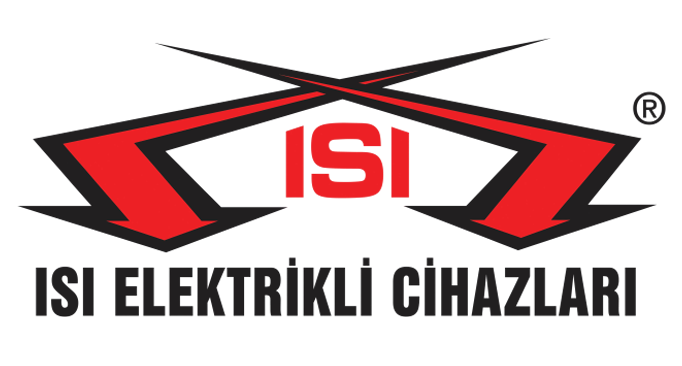
-500x500w.jpg)
-500x500w.jpg)
-500x500w.jpg)
-500x500w.jpg)
-500x500w.jpg)
-500x500w.jpg)
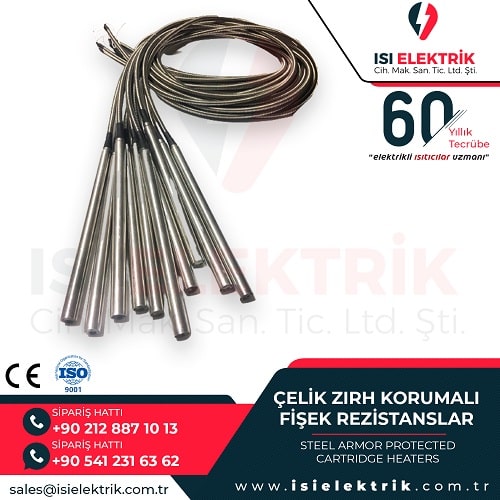
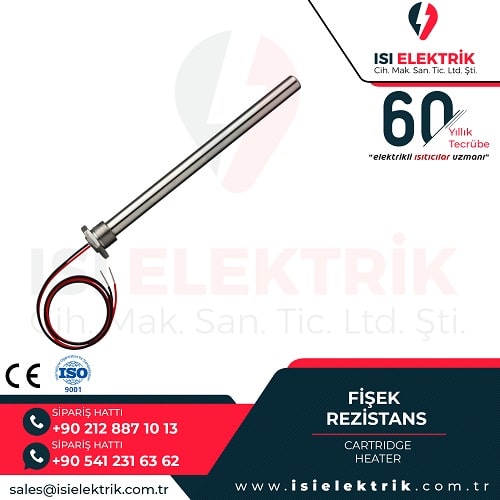
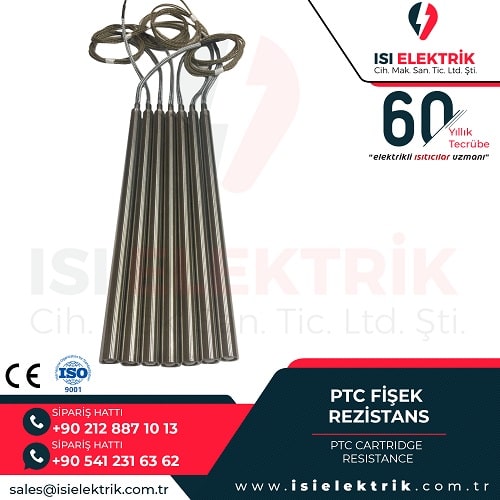
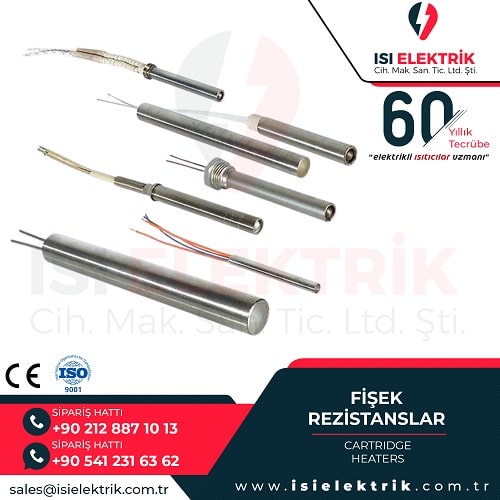
-min-500x500.jpg)
